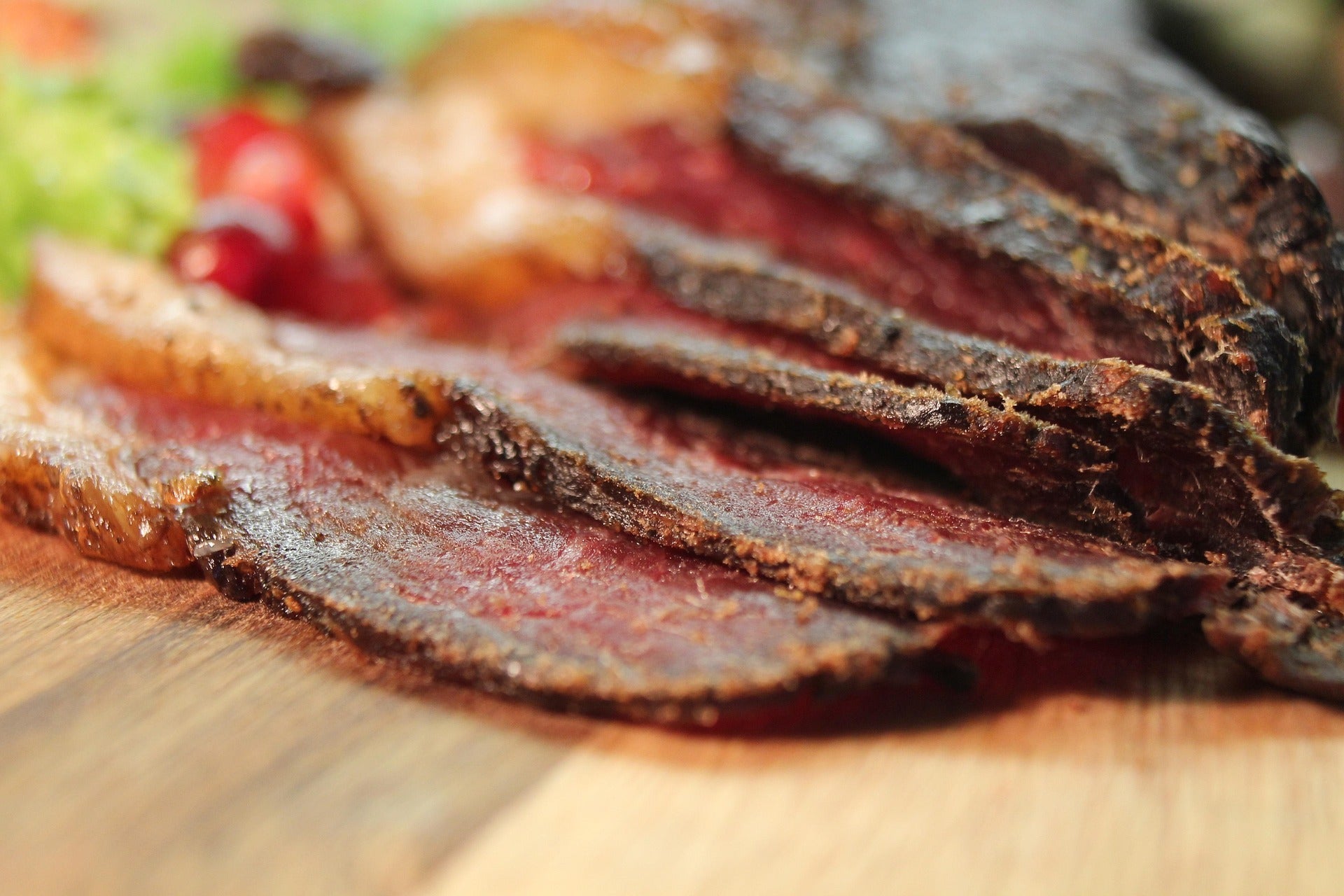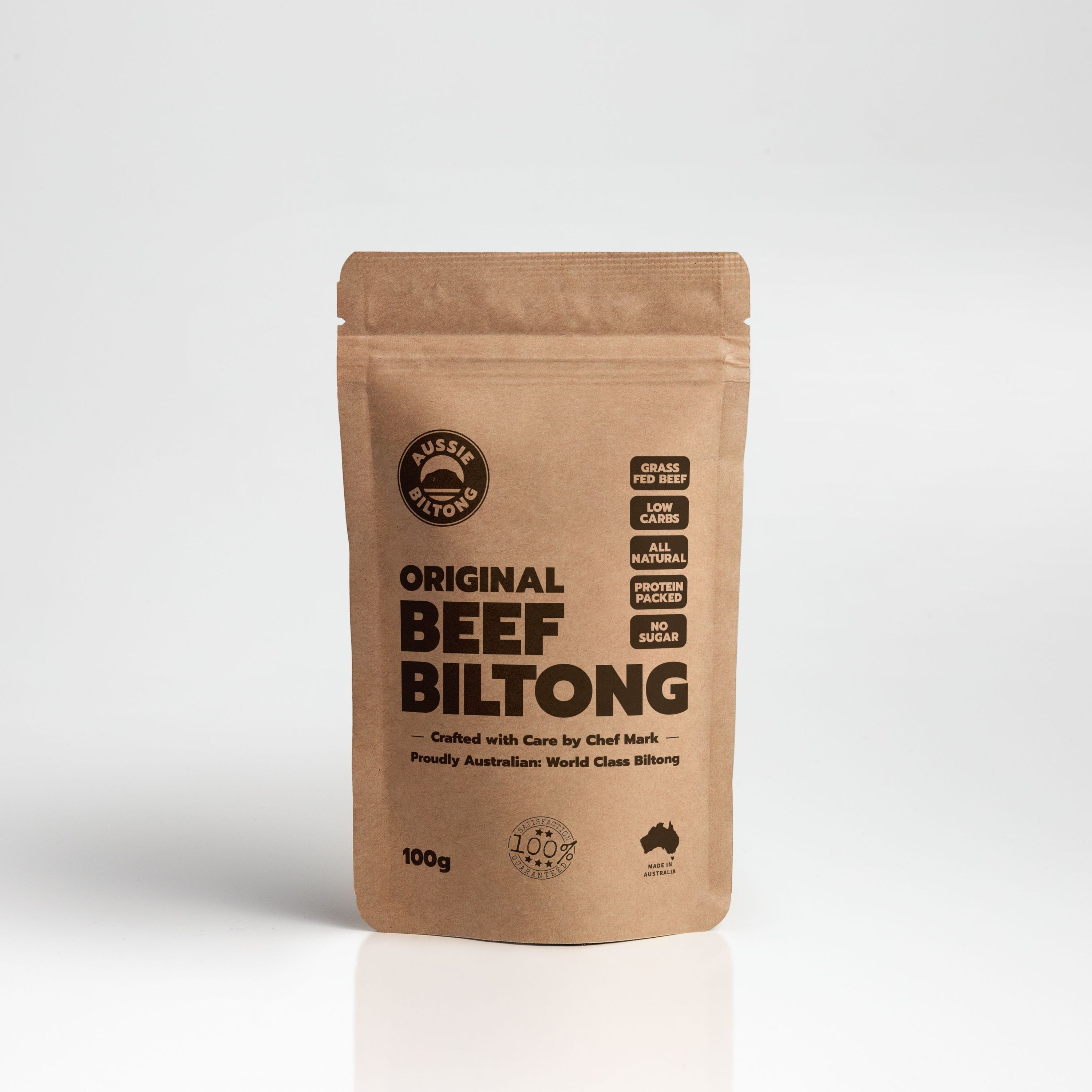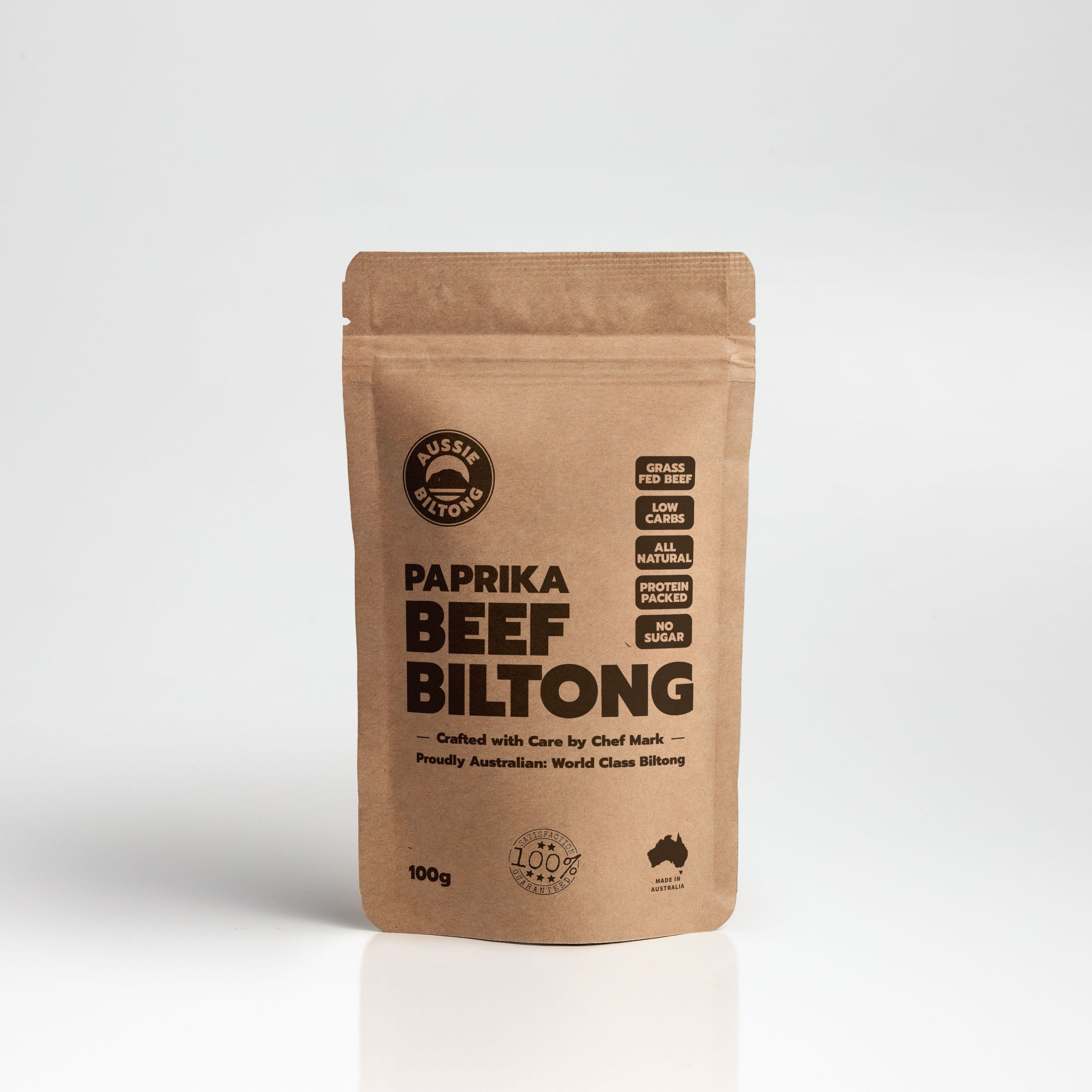

· By Aussie Biltong
What is Biltong: The Bold, Savoury Snack That Packs a Punch
Looking for a high-protein snack that actually tastes good? Say hello to biltong, South Africa’s answer to jerky, but with bigger flavour, better texture, and no added sugar (now made in Australia, thanks Aussie Biltong).
Here, we’ll break down exactly what biltong is, how it’s made, and why it’s fast becoming Australia’s go-to meat snack.
What Is Biltong?
Let’s clear this up right away. Biltong is not just dried meat. It is a flavour-packed, air-dried, protein-rich strip of goodness.
It comes from South Africa, but Aussies are catching on fast. The word itself comes from Dutch. "Bil" means rump, and "tong" means strip or tongue. So literally, meat strips.
But this is no ordinary snack. Biltong is cured using vinegar, salt, and a handful of bold spices. Then it is left to dry slowly in the air. No cooking. No smoking. Just time, patience, and a flavour punch that hits hard.
Unlike other dried meat snacks, biltong delivers a soft chew, deep umami, and natural ingredients you can feel good about. Whether you are eating it on the go, after the gym, or in front of the telly, biltong is a step above.
History and Origins
Biltong has been around longer than fridges and protein shakes.
The Khoikhoi people of Southern Africa were drying meat in the sun centuries ago. It was all about preserving food during hot, dry seasons when fresh meat was scarce. Then the Dutch settlers came along in the 1600s and added vinegar and salt to the drying process. That kicked off what we now know as traditional South African biltong.
Families started making their own. Every household had its recipe. Vinegar, coriander, black pepper, cloves – it became part of the culture. And still is today. In South Africa, you will find biltong at sports events, petrol stations, butcheries, and school lunches. It is more than a snack. It is a tradition.
Ingredients and Flavour Varieties
Traditional biltong keeps things simple. Here is the classic recipe:
-
Lean meat (usually beef)
-
Vinegar
-
Salt
-
A mix of spices like coriander, black pepper, and cloves
But if you think biltong only comes in one flavour, think again.
Today’s biltong world is packed with variety. There is peri-peri biltong for spice lovers. Garlic biltong for bold flavour fans. Chilli, smoky BBQ, sweet-and-spicy blends – even native Aussie flavours like lemon myrtle or bush tomato.
Texture options vary too. Some like it wet and juicy with a layer of fat for extra flavour. Others prefer it medium or dry and lean for a longer shelf life. There is no right or wrong. Just what suits your taste.
Types of Meat Used
In Australia, beef biltong is the most popular choice. It is usually made from:
-
Silverside – lean, consistent, and quick to cure
-
Topside – slightly marbled for added depth and tenderness
But beef is only the beginning.
In South Africa, biltong comes in all kinds of meats:
-
Game meats like kudu, springbok, and eland
-
Ostrich – lean, slightly sweet, and rich in protein
-
Chicken, turkey
For adventurous eaters, there are plenty of non-beef options. Each meat offers a different flavour profile, texture, and drying time. Want something lean and wild? Try ostrich. Want something traditional? Beef is your mate, at Aussie Biltong we use 100% Australian. grass fed beef.
Biltong vs Beef Jerky: What’s the Difference?
Think biltong is just South African jerky? Think again. They might look similar, but the difference is night and day.
Here is a side-by-side breakdown:
|
Feature |
Biltong |
Jerky |
|
Origin |
South Africa |
USA |
|
Drying Method |
Air-dried with no heat |
Cooked or smoked |
|
Curing Process |
Vinegar, salt, and spice blend |
Sauce or sugar-based marinades |
|
Cut Thickness |
Thick-cut strips or slabs |
Thin, bite-sized slices |
|
Flavour Profile |
Tangy, savoury, spice-forward |
Sweet, smoky, often sugary |
|
Texture |
Chewy, moist, sometimes fatty |
Dry, leathery, and firm |
|
Shelf Life |
Shorter unless vacuum-packed |
Longer with preservatives |
Biltong is thicker, more natural, and closer to what meat is meant to taste like. Jerky, on the other hand, is usually cooked, sweetened, and preserved with additives.
If you are watching carbs, avoiding sugar, or prefer natural protein snacks, biltong is the better fit.
Biltong Nutrition and Health Benefits
Besides flavour, one of the biggest reasons people choose biltong is for the health perks. This is not just another snack. It is a clean, nutrient-dense, high-protein option that fits into nearly every diet.
High in Protein
Biltong packs a serious protein punch. You are looking at up to 50 grams of protein per 100 grams. That is more than most protein bars and with zero fillers.
Low in Sugar and Carbs
Traditional biltong has no sugar. No honey. No brown sugar marinade. Just vinegar and spices. That makes it perfect for keto, low-carb, paleo, and high-protein diets.
Rich in Iron and B Vitamins
Being a red meat product, biltong delivers iron, zinc, B12, and essential amino acids that keep your energy levels up and your immune system strong.
Gluten-Free and Dairy-Free
Most biltong is naturally gluten-free, dairy-free, and preservative-free. Always check the label, but most quality Aussie brands keep it clean.
Long-Lasting Energy
The mix of protein and fat makes biltong a slow-burning fuel source. Great for hiking, travel, work, or long gym sessions.
No sugar crashes. No artificial nonsense. Just real fuel from real food.
How To Enjoy Biltong
One of the best things about biltong is how flexible it is. You can eat it just about anywhere, at any time, and for any reason, no prep, no mess, no fuss.
It’s the perfect on-the-go snack. Whether you’re heading to work, stuck in traffic, or powering through a long meeting, biltong gives you a quick protein hit without the sugar crash that comes with biscuits or muesli bars.
If you’re into fitness, biltong makes an ideal pre or post-workout snack. High in protein and low in carbs, it helps with muscle recovery and keeps hunger in check. Chuck a pack in your gym bag, and you're sorted.
Planning a hike or road trip? Biltong is a trail-friendly snack that doesn’t need refrigeration and won’t crumble or melt. It’s lightweight, filling, and gives you the long-lasting energy you need for outdoor adventures.
It also fits right into your afternoon snack routine. You know that slump around 3 pm when you’re reaching for something to munch? Skip the vending machine and tear open some biltong instead. You’ll stay full and focused without the sugar rush.
Hosting mates? Biltong works brilliantly on a snack platter. Pair it with cheese, olives, dried fruit, or a cold beer. It’s a crowd-pleaser that adds something different to the mix, chewy, salty, and packed with flavour.
And if you’re a bit of a foodie, try using biltong in your cooking. Sprinkle shaved pieces over salads, add it to omelettes, or use it as a topping on sourdough toast with avocado. It’s an easy way to boost protein and punchy flavour in just about anything.
Whenever you're hungry and want something satisfying, biltong is always a solid choice.
How to Store Biltong
Storing biltong the right way keeps the texture spot on and prevents spoilage. Whether you like it moist and fatty or dry and chewy, here’s how to get the most out of every pack:
Unopened packs
Keep them in a cool, dry place, away from heat and direct sunlight. Pantry, drawer, or cupboard is perfect. If it’s vacuum-sealed or nitrogen-flushed, it’ll stay fresh until the best-before date no fridge needed.
Opened packs:
Once opened, air and moisture become your enemy. Reseal the bag tightly if it has a zip-lock. If not, transfer the biltong to a zip-lock bag or airtight container, squeezing out as much air as possible. For longer freshness, use a vacuum sealer if you’ve got one.
Fatty or wet biltong:
These juicy cuts have higher moisture, which means more flavour but also a higher risk of mould if left out. Store in the fridge immediately after opening. Wrap in a paper towel before sealing to absorb excess moisture and keep it fresher for longer.
Dry biltong:
If your biltong is on the drier side, you can keep it at room temperature for a few days. Just make sure it’s sealed well in an airtight bag or container and stored away from any humidity or steam.
Want to make it last longer?
Freeze it. Wrap the biltong tightly in plastic wrap, foil, or use a vacuum bag. Then pop it in the freezer. When you're ready to snack, let it defrost slowly in the fridge overnight for the best texture. Avoid microwaving, as it ruins the texture.
What to Look for When Buying Biltong
Not all biltong is made equal, and knowing what to look for can help you avoid the dry, flavourless stuff and find the real deal. Start with the ingredients; the fewer, the better. A great biltong should have simple, clean ingredients you can pronounce. Meat, vinegar, salt, and spices. That’s it. If the label starts listing sugars, preservatives, or mystery additives, it’s probably not the kind you want.
Pay attention to the meat source too. Grass-fed beef is a strong sign of quality, especially when it’s locally sourced from Australian producers. You’ll taste the difference in both flavour and texture.
The drying method also matters. Traditional air-drying gives biltong its unique chew and depth of flavour, unlike cooked or smoked versions that lose a bit of that natural character.
You might also want to consider fat content. Some biltong comes with a nice strip of fat, which adds richness and mouthfeel but it can also mean a shorter shelf life. If you prefer a longer-lasting option or just enjoy a leaner bite, dry biltong is the way to go.
Don’t be afraid to experiment with spice blends. From classic coriander and pepper to garlic, chilli, or peri-peri, there’s a lot out there to suit different tastes.
Lastly, packaging plays a role. Resealable bags or vacuum-packed pouches are ideal for keeping things fresh, especially if you’re snacking over a few days. And if you can support Aussie brands while you’re at it, even better. You’ll be getting fresher biltong while helping local makers do what they do best.
Final Bite
Biltong is more than a snack. It is an experience. From its humble South African beginnings to its rise across Australian snack shelves, biltong has carved out a spot as a clean, protein-rich, seriously tasty dried meat treat.
Whether you are after traditional biltong, spicy peri-peri, or garlic beef with a fat cap that melts in your mouth, there is a variety waiting for you.
So next time you reach for a sugary bar or packet of chips, stop.
Grab a pack of biltong instead. High in protein. Packed with flavour. Ready when you are.

